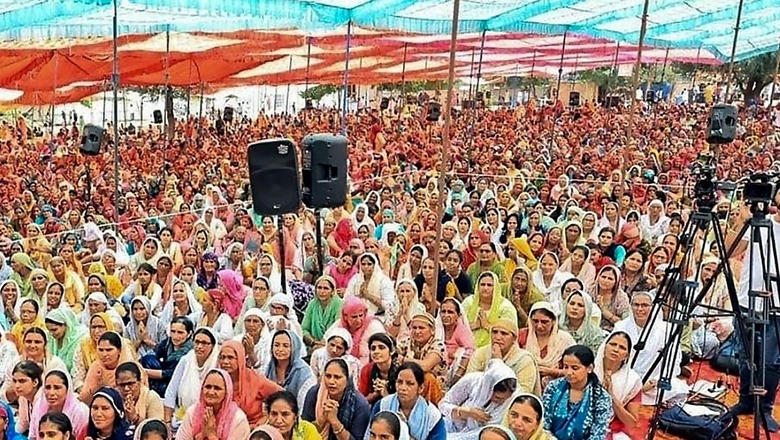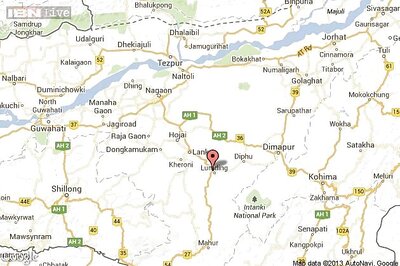
views
It has been four days since the Hathras tragedy. The dust is yet to settle, the mud still drying in the fields of Phulrai village in the Mandi area of the Sikandrarau region in Hathras district, Uttar Pradesh. It was in an attempt to collect this very ‘holy’ dust and mud, left behind by the caravan of Suraj Pal Singh, alias Narayan Sakar Hari (the name translates to God incarnate), also known as Bhole Baba, a police constable turned self-styled guru, that over a hundred people, mostly women and children, died at the end of his satsang (religious congregation) held on July 2.
Lessons Unlearned
The Hathras satsang tragedy is neither the first nor the last. Sadly, the harsh lessons from all past such cases have largely been unlearned. The religious congregation in Hathras is neither unique nor the worst, and it will be no surprise if another such case unfolds soon in another part of the nation.
Mass religious congregations worldwide, in which hundreds of thousands and millions gather, have always been prone to stampedes, leading to large-scale, unfortunate deaths. This year’s Hajj, which witnessed more than 1,300 deaths (including over 100 Indians), is not an isolated event. On September 24, 2015, during Hajj, a gigantic stampede at the site of the stoning of the stelae in Mina near Mecca left more than 2,400 people dead, in one of the deadliest disasters of its type.
Bharat, too, is home to many such tragedies at frequent intervals. I will return to this later in this article. Every time a major tragedy occurs, inquiries are announced and held, and criminal cases are lodged and investigated. But no lessons are learned. Nothing changes. Then another tragedy unfolds. Despite so many tragic events happening, there are more questions than answers.
This piece aims to dig deep beneath the surface, tracing the root causes behind such tragedies and exploring possible ways to prevent them. It also examines how to reduce casualties and mitigate the devastating impact when such mishaps are unavoidable.
Numbers Game
The official death toll from the Hathras stampede stands at 121, including 112 women, as reported by UP Director General of Police Prasant Kumar. The number of injured officially has been pegged at 28. According to officials, all bodies have been identified and handed over to their next of kin. However, reports indicate that the casualty numbers may be higher, with many still searching for missing or injured relatives. In a congregation of 250,000, the number of casualties in what is arguably one of the deadliest such tragedies will always be a matter of conjecture.
Game of one-upmanship
Even before the dead in the July 2nd tragedy were counted, identified, and cremated, a political slugfest and game of one-upmanship began, with the Opposition training its guns on CM Yogi Adityanath.
Akhilesh Yadav, the Samajwadi Party supremo, thundered on July 4, “There cannot be a conspiracy behind the Hathras stampede, but it can definitely be a conspiracy that the government wants to run away from its responsibility in this matter.” Congress party leader Rahul Gandhi, Leader of the Opposition in the Lok Sabha, visited family members of the deceased on July 5 and said there were lapses on the part of the government.
A petition has been filed in Allahabad High Court seeking an investigation by the CBI. Another petition filed in the Supreme Court seeks direction to the UP government to submit a status report. This petition has also sought direction from the apex court to appoint a five-member expert committee, under the supervision of a retired Supreme Court judge, to inquire into the tragedy.
Action After the Disaster
On its part, the UP government, with top ministers and bureaucrats present at the site of the tragedy and hospitals, and with the help of NDRF, SDRF, and local administration, dexterously completed the rescue and relief operations. CM Yogi Adityanath visited hospitals on July 3. The police have registered a criminal case against one Devprakash Madhukar, alias Mukhya Sewadar, and other organisers of the satsang. Additionally, the Uttar Pradesh government has set up a three-member Judicial Inquiry Commission under the chairmanship of retired Justice Brijesh Kumar Srivastava of the Allahabad High Court.
Fatal Attraction
Bharat, the cradle of civilisation, the birthplace of many religions – which also early embraced religions originating outside (Christianity and Islam) – has frequently witnessed the emergence of holy men and saints of all genres. The fatal attraction to holy men and women, genuine and not so genuine, has been so strong that many holy men develop cult followings from time to time.
The cult following of Bhole Baba, a self-proclaimed spiritual leader, is so enormous that the Hathras satsang reportedly had around 250,000 attendees from at least 15 districts of Uttar Pradesh and many neighbouring states, even though Bhole Baba appears to be a conman of dubious distinction.
Dubious Distinction
Indubitably, there is more than meets the eye regarding Bhole Baba, a 12th-grade graduate who wears a white suit and tie, has a penchant for expensive cars and perfumes, is fiercely guarded by three tiers of private militia (including an inner core of “black commandos”), and was formerly a constable in the UP Police.
Suraj Pal Singh has a chequered past. In 2000, almost immediately after taking voluntary retirement from the UP police force to become a baba, he was arrested in Agra after allegedly snatching the body of a 16-year-old girl from her family, claiming he could bring her back to life. A criminal case was lodged against him, but, as happens in most such cases, the police later filed a closure report citing a lack of evidence.
Just One God
Followers of Bhole Baba believe that he, the soil taken from the places he walks, and the holy water from his satsang have the power to cure chronic illnesses, heal, and rid people of evil spirits. He is also believed to have the power to bring the dead back to life. For most of his followers, largely from the lower strata of society, there is just one God: Bhole Baba. In the homes of his ardent followers, photos of all gods and goddesses have been replaced by those of Bhole Baba. Ironically, many followers believe that it was he who predicted the Hathras tragedy. Apparently, just before leaving the satsang site, he took the mic and announced, “I am departing now; the apocalypse shall follow soon.”
Symptoms of a Deeper Malaise
India exists in a fascinating paradox when it comes to holy men. Some are revered, others controversial, yet their influence—in life and even centuries after death—remains a potent force. These figures often command a devoted following, bordering on cult-like adoration. However, the tragedy surrounding figures like Bhole Baba exposes a darker side to this phenomenon. Despite hundreds perishing at his gathering, he remains elusive, blaming conspiracies rather than taking responsibility. And sadly, history suggests this cycle will likely repeat itself. The crowds will forget, Bhole Baba will resurface, and the deeper malaise at the heart of such blind devotion will continue to fester.
Babas of his genre thrive by playing on the irrational emotions of the have-nots, mired in dire poverty, ignorance, and superstition. They prosper at the intersection of unwavering faith and devotion from followers who blindly believe in their supposed divinity. It is this faith of gullible millions that becomes the main source of power for these godmen, a power further worsened by growing inequity and inequality, societal injustice and stratification, and religious obscurantism. Time will tell how history remembers Bhole Baba—as the “only one God” or as another entry on a growing list of infamous, self-styled conmen-turned-criminal godmen like Asaram Bapu, Baba Ram Rahim, and the now largely forgotten Chandra Swami and Dhirendra Brahmachari.
The Travesty of Justice
Nevertheless, Bhole Baba and his accomplices must be apprehended and prosecuted for the deaths of 121 hapless women and children. The UP police have filed an FIR against Pramukh Sevadar and other organisers under various sections of the new criminal law – Bharatiya Nyaya Sanhita (BNS) 2023, including Sections 105 (culpable homicide not amounting to murder), 110 (attempt to commit culpable homicide), 126(2) (wrongfully restraining a person from moving in any direction), 223 (disobedience to an order duly promulgated by a public servant), and 238 (causing disappearance of evidence of an offence or giving false information to screen an offender).
The main organiser, Mukhya Sevadar, has vanished. A bounty of one lakh has been announced for information leading to his arrest. Six minions have been arrested; they were volunteers tasked with managing crowd control, collecting donations, and planning. It will be difficult to find witnesses to convict them. Even in the unlikely event of their conviction, the maximum penalty would be a couple of years in prison because they can be tried under Sections 105 and 110, which pertain to culpable homicide leading to five to seven years imprisonment.
I call it a travesty of justice.
Invincible Bhole Babas
Baba Bhole is not named in the FIR. Currently, he is in hiding, either in an opulent ashram or at the home or farmhouse of a wealthy patron. Even if he surfaces, under which section of BNS will he be charged? Being a religious preacher is not a crime. He came to preach at an event organised by followers, an event thronged by devotees. He had no way to count the number of devotees. And there was a stampede. Legally, it is difficult to prosecute him. It would be like prosecuting a political leader for a stampede at a political rally they addressed.
However, there is a glimmer of hope for justice. He appears to be a serial offender.
A Serial Offender
Bhole Baba appears to be a serial offender. He was arrested in 2000 in Agra. In 2022, one of his satsangs received permission for 50 attendees but 50,000 attended. In yet another recent revelation, the police said that whenever Bhole Baba visits Rajasthan, he stays at the home of Meena, the alleged main accused in the Rajasthan 2020 Junior Engineer recruitment exam paper leak.
These cases may just be the beginning.
Muddled Sequence of Events
It will never be known what sparked the Hathras stampede. Four days after the heartbreaking massacre of innocents, one cannot retrace the sequence of events. Nonetheless, a few pointers have emerged: the site was severely overcrowded; the huge, makeshift tent had only one exit; nearby areas were full of mud and slush; it was scorching hot, typical of a sweltering summer; devotees were either prostrating themselves at the feet of the departing Baba or trying to collect holy soil/mud from the ground after he left; and the site was devoid of medical facilities and safety measures.
There were no public announcements or guidance. For an event of this scale, protocols demand adequate police and security presence—especially if it was a private event at the organiser’s cost. None of this was in place. Given the scenario, the police case will likely soon be closed for lack of evidence, and the nation will await another such tragedy.
Such is the litany of woes. But before continuing, let me briefly touch upon a chink in the armour.
Chink in the Armour
India, in recent years, has vastly improved its infrastructure and response time in tending to disasters. The NDMA and NDRF have earned accreditation for their efforts.
Nonetheless, the massive casualties in the Hathras tragedy, set in a rural area, have exposed a chink in the armour of disaster preparedness. The Sikandararao Community Health Centre (CHC), at the epicentre of the Hathras disaster, was woefully overwhelmed when tragedy struck. Staffed with only one doctor, three nurses, one ward boy, one pharmacist, one sweeper, and equipped with a mere three oxygen cylinders, the CHC had no space to treat the dying or house the deceased. The scene was so chaotic that one nurse even fainted.
With no beds to accommodate the injured, and many brought in alive dying due to the lack of medical facilities, this tragedy is a wake-up call to improve healthcare facilities in district hospitals and below. Sadly, Hathras will not be the last such disaster.
Litany of Woes
Deadly stampedes are common occurrences at Indian religious festivals and congregations, where large crowds gather in cramped spaces with inadequate infrastructure and few safety measures, if any. The root causes of such events are rarely identified, accountability is seldom established, and culprits often evade justice. Measures to prevent and mitigate such incidents are seldom implemented. Most such tragedies occur in rural areas, hilly regions, riverbanks, and other locations lacking proper infrastructure and adequate containment measures.
The litany of woes continues, and one tragedy worse than the next continues to unfold. Such is the fate of Bharat.
It Should Have Stopped Long Ago
Since independence, India has witnessed numerous disasters during religious festivals, congregations, and pilgrimage centres—both natural and manmade—resulting in tens of thousands of casualties. The worst natural disaster occurred in 2013, killing over 6,000 people at Kedarnath. Human-caused stampede deaths have also been frequent, with the worst occurring on February 3, 1954, during the Allahabad Kumbh Mela, where reportedly nearly 1000 people were trampled to death.
India has a poor track record of accurately counting deaths and injuries at religious congregations. The data collected by NCRB is highly unreliable, as it simply compiles numbers reported by state police. My own research estimates deaths over the last three decades between 6,000 and 10,000, with serious data asymmetry persisting, and approximately 25,000 injured. Some high-profile stampede-related deaths in recent years include 400 at the Mandher Devi stampede in Maharashtra (2005), over 250 deaths at the Chamunda temple (2008), over 150 deaths at Naina Devi in Himachal Pradesh (2008), more than 105 deaths at the Sabarimala stampede (2021), and over 115 killed in a stampede during Navratri festivals in Madhya Pradesh (2013).
The list is endless, and documenting all incidents is beyond the scope of this piece. Suffice it to say, no remedial measures have been taken, and no lessons have been learned.
The Root Cause Analysis
Why do such stampedes continue to happen? There are many reasons, including but not limited to overcrowding, mass panic, cramped spaces, lack of safety measures, poor infrastructure, and inadequate management. It is often difficult to determine the specific triggers of a stampede.
In 2013, in the Wall Street Journal, Teresa Moore, from the International Centre for Crowd Management and Security Studies in the UK, suggested a reason specific to India: “The higher tolerance for crowded spaces in India allows people to get closer because they don’t feel uncomfortable until it is very packed. Such crowds often grow too large, too quickly, causing panic and reactions.” She added, “Couple that with a rumour, which can arise from panic, and that’s when you can get a surge or a problem.”
A significant part of the problem is that India’s largest religious festivals often take place in rural areas, hilly terrain, foothills, and riverbanks, which lack the infrastructure, preventive measures, and containment measures to manage such events.
In recent times, two Swiss professors—Anna Sieben and Dirk Helbing—have provided insights into stampede events. Anna Sieben, an associate professor of cultural and social psychology at the University of St. Gallen in Switzerland, who has researched crowd dynamics for years, believes that people caught in a stampede often fail to realise something is wrong until it’s too late.
Dirk Helbing, a professor of computational social science at ETH Zurich in Switzerland, agrees with this view, stating, “A common understanding of crowd disasters is that they result from panic, a state of mind driven by anxiety and fear, which heightens adrenaline levels. This activates the fight-or-flight instinct, causing people to flee in panic, sometimes trampling others in their path. While such situations can occur, most crowd disasters do not unfold in this manner.”
Helbing further explains that stampede tragedies are often caused by physical forces, such as ‘crowd turbulence.’ He describes crowd turbulence as occurring when many people move into a confined space with high density, leading to ‘force transmission’ between individuals. If someone stumbles and falls, it can create a gap in the crowd. Those adjacent lack opposing force to prevent falling, leading to a cascading effect, potentially causing a ‘deadly domino effect’.
Containing the Curse
With an increasing population and growing influence of godmen, alongside heightened religious fervour, the crowds at pilgrimages and religious congregations are bound to swell further in the country, becoming increasingly unmanageable over time.
There is an urgent need to take comprehensive action to prevent such events and manage the aftermath of tragedies. The country’s disaster management architecture needs refurbishment to address human-caused tragedies effectively. This includes revisiting the NDMA (2014) guidelines for planning congregations, preventing disasters, and managing crowd-related issues through capacity building and rigorous enforcement.
Mass religious congregations will continue to be scattered across undulating terrain, village landscapes, inaccessible hilly areas, foothills, riverbanks, and other vulnerable locations. These terrains, lacking proper pathways, pose geographical risks to devotees. Steep slopes, uneven topography, dead ends, slippery and muddy floors like those in Hathras, and narrow passages are key risks that need mitigation.
The country needs dovetailed, area-centric infrastructure development and commensurate safety and security measures. There needs to be a stronger emphasis on stringent guidelines for approving such events, conducting site inspections, assessing crowd capacity, implementing robust evacuation strategies, ensuring adequate ventilation, establishing multiple entry and exit points, conducting mock drills for stampede control, and ensuring a sufficient number of police and security personnel (with costs borne by private event organisers). Mandatory provisions should include emergency services, fire safety measures, and disaster management training for organisers covering both prevention and containment measures. Periodic and robust risk identification and mitigation protocols need to be established for both uni-directional and turbulent stampedes, as the Hathras tragedy—which tragically falls into the latter category—demonstrates.
The author is Multidisciplinary Thought Leader with Action Bias, India Based International Impact Consultant, and key watcher of changing national scenario. He works as President Advisory Services of Consulting Company BARSYL. Views expressed in the above piece are personal and solely those of the author. They do not necessarily reflect News18’s views.


















Comments
0 comment